NVIDIA Launches Shield Tablet
by Joshua Ho on July 22, 2014 9:00 AM EST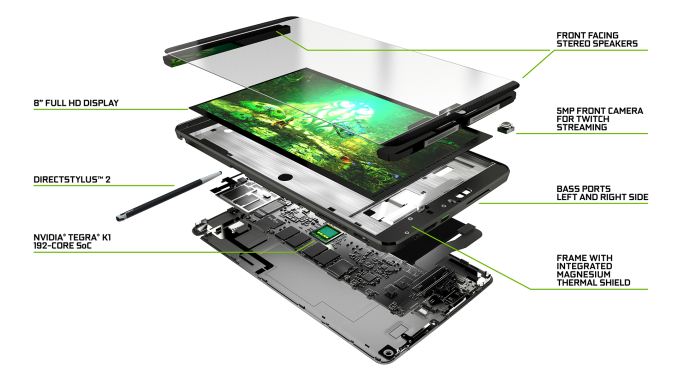
Today, NVIDIA is announcing the Shield tablet. While normally such launch announcements don’t require much in the way of exposition, NVIDIA is in an odd place. Last year, the Shield portable and Tegra Note 7 were the primary mobile devices shipping with Tegra 4. In hindsight, the Shield portable was a bit too niche to ever reach mass adoption. It was first and foremost a gaming device, with a display attached to a controller as opposed to a controller attached to a display. The result was that while it was surprisingly good for gaming, it wasn’t the best tablet. It really only worked in landscape mode, the display size was relatively small (5 inches diagonal), and using the touchscreen was an awkward experience.
The Tegra Note 7 was NVIDIA’s attempt at competing in the mainstream tablet market. While the dual front facing speakers and stylus were good advantages over the Nexus 7, it wasn’t clearly better than the Nexus 7. The display was lower resolution, lower contrast, and not as well calibrated. The WiFi module only supported 2.4 GHz, and there was only a gigabyte of RAM. While it was possible to emulate a Shield-esque experience with the Note 7, there was no game streaming from PC to tablet due to the lack of 5 GHz WiFi, and the controllers on the market simply weren’t as good as the controller in Shield. In addition, because the Tegra Note 7 wasn’t directly controlled by NVIDIA the experience in software update speed could vary.
From the lens of past experience, the Shield tablet makes a lot of sense. The specs are right for a good tablet, but it’s also a proper Shield device. As a tablet, it has all the right pieces. A high resolution display, Tegra K1 (Cortex A15 variant), dual front facing speakers and bass reflex ports, a new stylus, 5 GHz WiFi, and a 5MP front facing camera. I’ve put a table of the specs below for easier reading.
| NVIDIA SHIELD Tablet | |
| SoC | Tegra K1 (2.2 GHz 4x Cortex A15s) |
| RAM/NAND | 2 GB DDR3L-1866, 16/32GB NAND + microSD |
| Display | 8” 1920x1200 IPS LCD |
| Network | 2G / 3G / 4G LTE (NVIDIA Icera i500 UE Category 3/4 LTE) |
| Dimensions | 221 x 126 x 9.2mm, 390 grams |
| Camera | 5MP rear camera, 1.4 µm pixels, 1/4" CMOS size. 5MP FFC |
| Battery | 5197 mAh, 3.8V chemistry (19.75 Whr) |
| OS | Android 4.4.2 |
| Connectivity | 2x2 802.11a/b/g/n + BT 4.0, USB2.0, GPS/GLONASS, mini HDMI 1.4a |
| SIM Size | None or MicroSIM |
In the stylus side, DirectStylus 2 is said to reduce the inking latency to half that of the implementation we saw in Tegra Note 7. In practice it seemed that the stylus latency was low and lines tracked closely to the stylus, but I’ll avoid final judgment until the review. NVIDIA also claims that there are more levels of pressure sensitivity, but it’s not quite clear how many levels there are. NVIDIA has also added handwriting recognition software, which worked relatively well in some casual testing. The Dabbler application also seems to provide a relatively realistic simulation of various physical mediums such as oil painting and watercolor, although it’s mostly targeted towards artists.
In addition to the stylus features, NVIDIA is advertising 1080p Netflix support. Normally, due to the DRM restrictions associated with high bitrate streaming, most Android devices only support low resolution streams. NVIDIA has done all of the necessary work to satisfy these DRM requirements, so it supports the highest bitrate available to mobile devices. Of course, this feature will be disabled with an unlocked bootloader, but it’s a good feature to have for mobile streaming.
Outside of tablet features, the gaming features seem to be quite compelling. The controllers themselves were comfortable, and were very similar to the Shield portable’s ergonomics. NVIDIA is emphasizing that these controllers connect over WiFi direct, and the frequency selected depends upon the network that is used. The result is much lower latency, and NVIDIA is also able to run a headset jack and microphone through the controller due to the higher bandwidth that WiFi provides. Up to four controllers can be paired to the Shield tablet for multiplayer games.
Due to the addition of 5 GHz 2x2 WiFi, NVIDIA’s GameStream and GRID, which means that it’s possible to stream games from a PC within the same LAN to Shield tablet and play games by streaming from NVIDIA servers to the tablet. NVIDIA did note that only 720p is supported through WiFi, and an Ethernet connection is necessary to stream at 1080p due to latency reasons.
While both GameStream and GRID are largely similar in experience compared to the Shield portable, the Kepler GPU in the Tegra K1 enables a great deal of potential for gaming. Trine 2 will ship with the tablet, and is a direct port from the console game. NVIDIA also showed off the improvements in games like Half Life 2 and Portal, which run full OpenGL rather than OpenGL ES as it did on Shield portable. Outside of feature set, NVIDIA is claiming that the K1's GPU is far faster than the GPU in either the Exynos 5420 or Apple's A7 SoC.
In addition, NVIDIA showed off a full version of War Thunder running on Shield tablet, and claimed that it will be able to play on multiplayer with PCs. This included both the tank and aircraft combat aspects of the game. NVIDIA also showed that the Unreal Engine 4 demo from Google IO runs on the Shield tablet.
Finally, the Shield tablet will be the first Android tablet to support streaming to Twitch. By leveraging the built in front facing camera, it’s possible to stream both gameplay and webcam/commentary. In practice, I didn’t see any noticeable issues with this system, and it seemed to work as promised. The 1.4 micron pixel size seemed to make the quality relatively acceptable even indoors.
That was a lot to go over, but I think the key here will be the native gaming experience on Shield tablet. While it’s fully possible for Shield tablet to serve as a dedicated console with GameStream, the real use case will be whether it can provide a solid gaming experience using the SoC for rendering rather than as a video decoder for a PC somewhere else. With games like War Thunder and Trine 2, it seems that there is immense potential for a very compelling product. While NVIDIA isn’t starting from nothing this time around, this ecosystem aspect is still a bit risky.
The Shield tablet will go on sale July 29th for the US, August 14th for Europe. The 16GB/WiFi variant will cost 299 USD, the 32GB/LTE variant will be 399 USD. The controller is priced at 59 USD, and the flip cover at 39 USD.


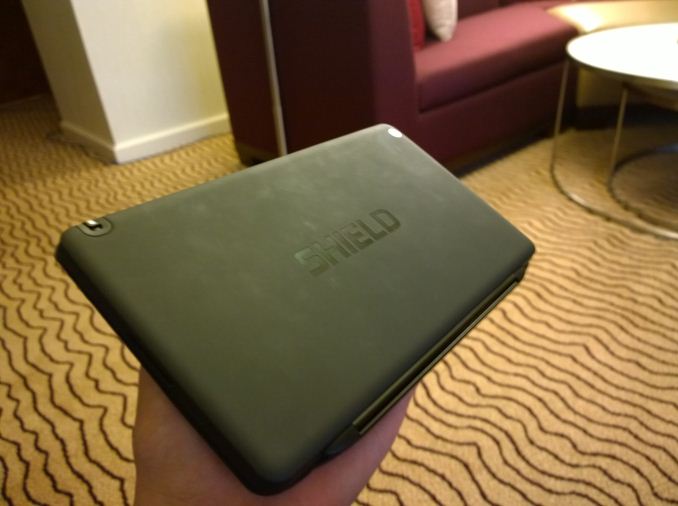
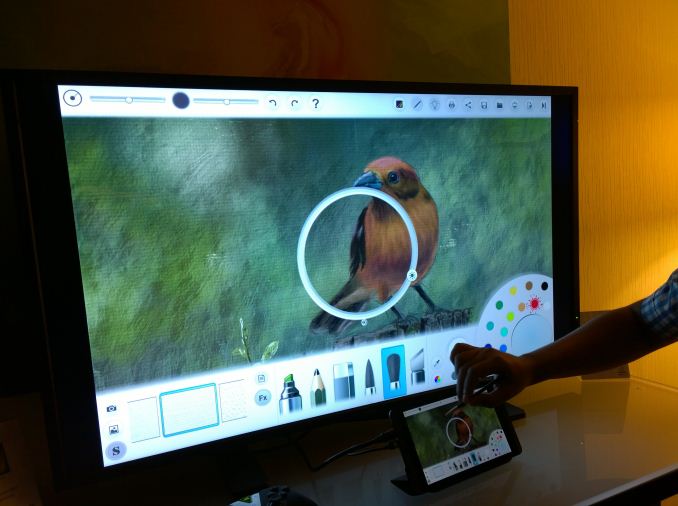
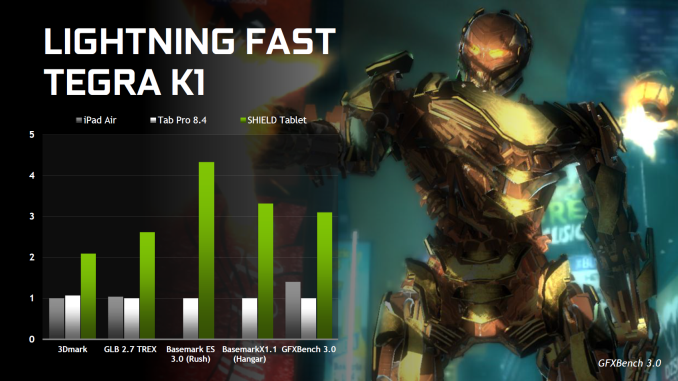
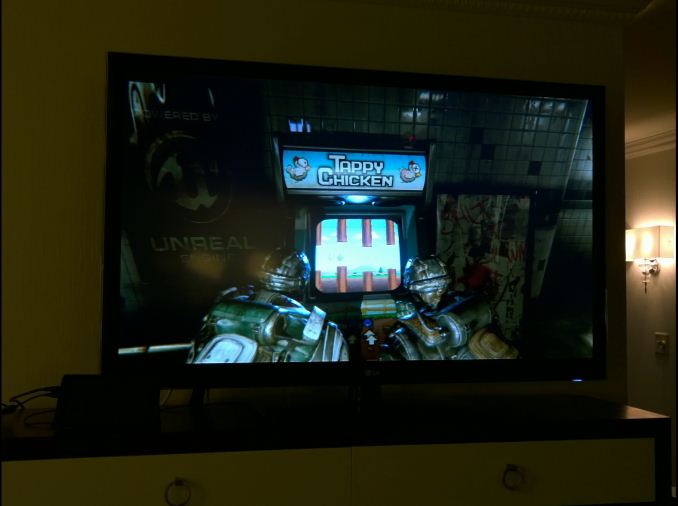
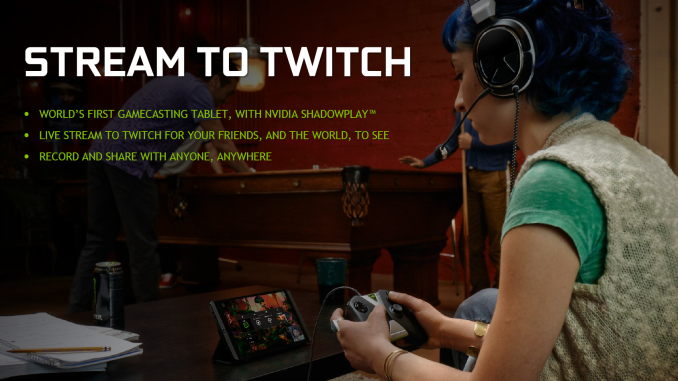








107 Comments
View All Comments
smorebuds - Tuesday, July 22, 2014 - link
True, currently the Android gaming market isn't full enough yet. But consoles are no longer the target platform for game developers like they used to be. There is more money to be made with Android/iOS, and it's probably only a matter of time (when mobile hardware truly allows for an Android gaming ecosystem) before the AAA developers start aiming for Android/iOS first--or at least equal to Windows.chizow - Wednesday, July 23, 2014 - link
Not sure if that's really the case given current Android games run from $7 to $10 max, most others are free and charge for microtransactions. That's quite a gap from the $50-60 that most big budget AAA titles charge. You're going to have to sell a ton of Android games to close the gap on some of the big sellers you see like GTA5, Watch_Dogs, Call of Duty etc.I think Android's best shot at success is the approach Nvidia is taking with full OpenGL support while closing the hardware gap and porting PC favorites (HL2, Portal etc). If they can slot in where the handhelds left off, with watered down Wii-like ports or 1-gen back ports of popular titles, I think they have a chance to grow the Android gaming platform, but as it is now, there's really nothing compelling that would interest me in strictly Android gaming platform as a user or developer.
At least with the traditional handhelds, you have popular 1st-party franchises or 3rd-party releases and remixes that you would expect on a handheld platform and still hold up well.
smorebuds - Wednesday, July 23, 2014 - link
Yes, currently those $7-$10 games are relatively simple and likewise cheaper to produce since the majority of Android gaming is done on phones/tablets. Touch screen gaming can only get so complicated, so what we have now are games tailored toward casual gamers. It's only a matter of time before hardware catches up and Android console gaming (or mouse/keyboard gaming) starts to take off. Or maybe console gaming won't ever make a comeback. Just because those "biggest sellers" cost $50-$60 does not mean they are more profitable, or even better games. And they are becoming few and far between now... I mean, not 5 years ago each quarter would have a slew of new AAA titles to get excited about. Now I can count an entire year's worth on my fingers... My point is that Android gaming is where the money is, and that's always been the most compelling reason for developers' choices of platforms. So it's only natural that once it becomes feasible, you can bet developers will be aiming for Android (and iOS) first. And in the case of small-medium companies/developers that don't have the resources to develop for all platforms... you can already see that decision being made.And don't think I'm anti-MS or anything... I actually like Win8.1 and finding myself defending it against idiots that write off the whole OS because they can't/don't want to adapt to for whatever reason. But unfortunately that has played a role in this whole consumer movement away from desktops and Windows in general. And I hate when people make arbitrary doomsday predictions, but it would seem that if this trend continues, Windows will eventually become just the OS for running legacy applications.
chizow - Thursday, July 24, 2014 - link
Sorry, that just doesn't add up, Gartner estimated Video Game revenues of $100 Billion for 2014. Nvidia says Google Play sees revenues of $250M last quarter (90% games), annualized you are looking at maybe 1.5-2B at best extrapolating growth rates. Singular titles are making more than that in any given year. In any case, there's a long way to go to bridge that gap.I'm also not sure about the number of exciting games decreasing, it seems to me there's so many to choose from I don't even feel compelled to buy more than 1-2 at release because I know they'll just go on sale by the time I am ready to play them.
Anyways, doesn't really have anything to do with Windows in this context, as a gaming machine Shield Portable will really be up against next-gen consoles first (same price point) and against handhelds second (loses here due to weak Android library and lack of compelling 1st/3rd party titles). If anything Nvidia is hoping to piggy-back on the PC market with their various GameStream technologies until Android gaming is strong enought to stand on its own.
TheJian - Tuesday, July 29, 2014 - link
https://www.gartner.com/newsroom/id/2614915Gartner says mobile gaming revenue was 13.2B. Epic games has said they made more from the Infinity Blade series than ALL of the Gears of War series per man hour invested and it only runs on Apple.
"Mobile games are the fastest-growing segment of the market, with revenue set to nearly double between 2013 and 2015 from $13.2 billion to $22 billion (see Table 1)"
Shield's competition is Vita/3DS/Xbox360/ps3. Of course as titles evolve on android and they shrink to 20/14nm yeah then REAL competition for consoles from ALL of mobile. Consoles aren't really portable, and you can't do tablet stuff at all on them (stylus, camera stuff etc, browsing etc, a kid can do some homework etc on these). Many uses past gaming. I expect a DIRECT console box after AndroidL +64bit chips hit and a 125w PSU box ships to directly compete.
Lack of compelling android titles? I'm pretty much ignoring sports/adventure types below (I tend to play strategy/rpg/action) as I am looking forward to playing others below first. I could go on but look at some of these on googleplay and you should get the point. Top paid apps have even more not listed here. Also note 50% of devs at GDC this year (60% last year leading the way) are MAKING games for mobile. Contrast that to consoles all with <20 (and only PS4) making stuff and you see where this is going. PC Now 52% and #1 just above mobile. It's clear even with $2-20 games the 1.2B unit per year sales on mobile is too large to ignore.
World at Arms (check this game out! WOW)
Modern Combat 5: Blackout (again, freaking WOW, android at it's best just hit july 23rd!)
Dungeon Hunter 3 + 4 (gameloft is an awesome DEV, looks like xbox360 games)
Captain America TWS
Rival Knights
Ravensword Shadowlonds (excellent)
Edge of Tomorrow (check out the graphics)
Injustice: Gods Among Us (check out the gameplay, multiplayer too)
Stilland War HD (adventure rpg, June 30 2014)
Asphalt 8
Amazing Spiderman
RPG Spectral Souls (large tactical RPG)
Need for Speed Most Wanted
Six Guns
Dead Trigger 2
Gangstar City
GT Racing 2
SoulCraft 2
Brothers in Arms 2
300 Seize Your Glory
Wild Blood (excellent)
Order & Chaos ONline
Eternity Warriors 2 (millions of installs)
Blazing Souls Accelate
Chaos Rings 1 & 2
Real Boxing
Gangstar Vegas
Bloodsword (very nice!)
ChoplifterHD fron inexile
TaintedKeep (for those adventure rpg types)
Riptide GP2
Gun Bros 2
Modern Combat 1-4
Iron Man 3 (impressive to say the least)
Frontline Commando
Nova 3 (nova 1 & 2 aren't bad either)
Dark Knight Rises:
Shadowgun (still think tablets gaming sucks?)
Gangstar Rio
Bard's Tale (hey, isn't this a CONSOLE game...LOL)
ArmA2: Firing Range (not as impressive, but this was 2011...LOL)
Renaissance Blood
Zombie Driver THD (just updated Aug1 specifically for shield)
Final Fantasy 3
Final Fantasy 6
Asphalt 7
COD Black Ops Zombie game...Who knew?
Great Battles Medieval THD (optimized for Tegra2...still looks good)
smorebuds - Tuesday, July 29, 2014 - link
You forgot XCOM (unless I missed it). Just started playing it and it's like the perfect game for phones and tablets (though Pokemon would take that title if it ever happens).fivefeet8 - Tuesday, July 22, 2014 - link
I wonder how they are accessing the Full OpenGL spec on Android as I don't believe the new Android extensions even do that. Opens the door for a fully capable Dolphin emulator to run on it though.ArthurG - Tuesday, July 22, 2014 - link
I believe Nvidia replaced the default Android OpenGL ES driver by their own full OpenGL version.JoshHo - Tuesday, July 22, 2014 - link
It still runs OpenGL ES, there is clear evidence that the driver for OpenGL is only loaded on application request.kron123456789 - Wednesday, July 23, 2014 - link
So, it actually can working with full OpenGL? I don't think that there is any android device that can do it.